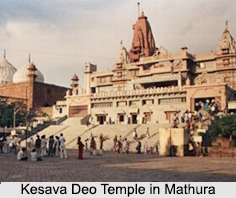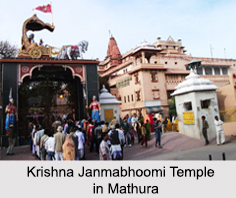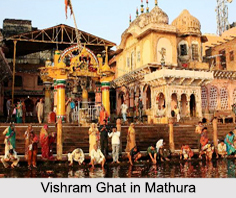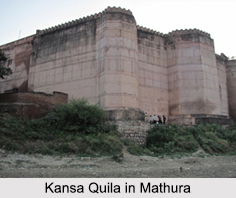 Mathura is a prominent religious city and pilgrimage destination, famous for being the birthplace of the much loved and adored Hindu God Krishna. It is considered one of the seven holiest places of the Hindus that are together referred to as the Sapta Puri . Located in the Indian state of Uttar Pradesh, it is the administrative headquarters of the Mathura district. Mathura was an economic hub during the ancient period, located at the junction of important caravan routes. It has been considered as one of the heritage cities for HRIDAY - Heritage City Development and Augmentation Yojana scheme of the Government of India. The city of Mathura finds a mention in the Garuda Purana, as one of the seven holy places for attainment of "Moksha".
Mathura is a prominent religious city and pilgrimage destination, famous for being the birthplace of the much loved and adored Hindu God Krishna. It is considered one of the seven holiest places of the Hindus that are together referred to as the Sapta Puri . Located in the Indian state of Uttar Pradesh, it is the administrative headquarters of the Mathura district. Mathura was an economic hub during the ancient period, located at the junction of important caravan routes. It has been considered as one of the heritage cities for HRIDAY - Heritage City Development and Augmentation Yojana scheme of the Government of India. The city of Mathura finds a mention in the Garuda Purana, as one of the seven holy places for attainment of "Moksha".
History of Mathura
According to the Archaeological Survey of India, Mathura is mentioned in the oldest Indian epic, the "Ramayana". In the epic, the Ikshwaku prince Shatrughna slew a demon named Lavanasura and claimed the land of the city. Then, the place was known as Madhuvan as it was thickly wooded, then Madhupura and later Mathura.
 Location and Area of Mathura
Location and Area of Mathura
Mathura is the nucleus of "Brajbhoomi", referred to as the land of Lord Krishna"s birth. It is located in the western belt of Uttar Pradesh, distanced 145 kilometers (90 miles) south-east to Delhi and 58 kilometers (36 miles) north-west of Agra. It is about 11 kilometers (6.8 miles) from the town of Vrindavan, also a part of Brajbhoomi, where Krishna had spent his eventful youth. The city of Mathura covers an area of 36.43 square kilometers (14.07 square miles).
Demographics of Mathura
The Urban Agglomeration of Mathura has a total population of 4, 56,706 inhabitants, of which 2, 44,359 constitute males and 2, 12,347 constitute females. The population of children between 0 to 6 years of age is 59,582. The effective literacy rate of the city is 75.49 percent, with the male effective literacy rate being 81.49 percent and female effective literacy rate being 68.62 percent. The sex ratio (population of females per 1000 males) is 869, while the child sex ratio is 851. The population density is calculated at roughly 12,536 inhabitants per square kilometer. Hindi is the main official language of this religious city.
Economy of Mathura
The industrial sector of Mathura encompasses the Mathura Refinery, owned by the Indian Oil Corporation and one of the biggest oil refineries of Asia with 8.0 MMTPA (Million Metric Tonnes Per Annum) capacity. Highly advanced in technology, Mathura Refinery is the first in Asia and the third in the world to receive the coveted ISO-14001 certification for Environment Management System in 1996.
The industries also include textile printing industry involving in both sari printing and fabric dyeing, along with silver ornaments producing. Mathura is also a major centre for production of cotton materials, prominent of which are the pure white bleached cotton saris for women, dhotis for men and cotton "niwar" tapes for beds. It is also a production hub of milk based sweet meals, prominent among them being the Mathura Pedas and Burfis. Mathura till today boasts of milk trading centers.
 Education in Mathura
Education in Mathura
There are many engineering and management colleges established in the Mathura city. Asia`s first veterinary college to award degree in Veterinary science is established in Mathura - Uttar Pradesh Pandit Deen Dayal Upadhyaya Veterinary University. It is the first of its kind in the state and the fourth to be made independent veterinary university in the country.
Religious Significance of Mathura
Mathura is religiously significant being the birthplace of Lord Krishna. On the very site where Lord Krishna took birth, which was a cell in an underground prison, is where the present day Kesava Deo Temple is established. According to the legendary epic Mahabharata, Mathura was the capital of the Surasena Kingdom, which was ruled by Kansa, the maternal uncle of Krishna.
Mathura as a Buddhist Pilgrimage Center
Mathura was once a Buddhist centre with 20 monasteries housing 3000 monks, until the rise of Hinduism and later sacking by the Afghan and Mughal rulers, post which only the beautiful sculptures recovered from the ruins are preserved and today on display at the Archaeological Museum.
Art and Culture of Mathura
The art and culture of Mathura has significantly contributed to the rich cultural heritage of the country. The ethos of Mathura centers upon Lord Krishna and his tales, and is expressed through various practices such as "Sanjhee", the colourful art of decorating flowers on the ground, "Rasiya", the integral tradition of folk songs highlighting the eternal love of Krishna and Radha. "Raas lilas" of Mathura have become an integral part of Indian Folklore. Krishna had danced the "Rasas" (aesthetics), with "gopis" on the banks of Yamuna River. "Charkula" is a traditional folk dance, where a woman balances a column of "deepikas" (oil flame-lit lamps) on her head and dances to the accompaniment of "Rasiya" songs by the men folk.
Festivals of Mathura
The multitudes of temples, which belong to various sects of Hinduism, proclaim Lord Krishna in different forms and avatars. Krishna Janmashtami in August/ September and Holi in March are the most enthusiastically celebrated festivals in Mathura. Along with these, Radhaashtami in September and Yam Dwitiya in October/ November are vibrantly celebrated.
 Places to Visit in Mathura
Places to Visit in Mathura
Mathura is today still a place that is religiously and aesthetically redolent and reverberating with the life and legends of Lord Krishna, with numerous temples, "ghats" and ancient "kunds" that depict the different episodes of Krishna"s life and are thronged by the ardent devotees and pilgrims. At dawn, many devotees are seen taking a holy dip in the holy waters of the Yamuna and at sunset, the daily evening "aarti" with "diyas" (oil lamps) floating over the river is a striking visual. Some of the visiting places of Mathura include:
Dwarikadheesh Temple
Krishna Balaram Mandir
Prem Mandir, Vrindavan
Kusum Sarovar, Govardhan
Baldeo (Dauji Mandir)
Shri Siddh Shani Mandir
Lohwan Mata Mandir
Shri Ratneshwar Mahadev
Gopinath Maharaj Mandir
Bhooteshwar Mahadev Mandir
Vrindavan Chandrodaya Mandir
Birla Mandir
Madan Mohan Temple
Naam yog Sadhna Mandir
Banke Bihari Temple
Radha Raman Temple
Rangeeli Mahal Barsana
Kokilavan
The Udasin Kashni Ashram
Shri Alkheswar Mahadev Mandir
Galteshwar Mahadev
Jama Mosque
Shahi-Eidgah Mosque
Jai Gurudev Ashram
Durvasa Rishi Ashram
Vishram Ghat (Mathura`s main ghat on the bank of Yamuna river)
Kansa Quila
Rangeshwar Mahadev Mandir
Mathura Archaeological Museum
ISKCON Temple
Visiting Information to Mathura
The best time to visit Mathura is the period between October and March. The summers are too extreme, while the winters are still suitable for a visit. Mathura can be conveniently accessed from major locations of the nation. It is inter-linked to other districts of Uttar Pradesh by the state transport service and is in proximity with several National Highways and the Yamuna Expressway that keeps the place connected to different Indian cities.
The connecting National Highways include the NH 3 connecting to Mumbai, NH 11 connecting to Ajmer, NH 93 connecting to Moradabad (Agra). Besides, the state transport system from the nearby states like Rajasthan, Chandigarh, Madhya Pradesh and Haryana serves Mathura. Mathura Junction is the busiest railway station in Mathura, a major halt in the Western Railway network. It connects the place to West, North and South India. The nearest airport to Mathura is the Kheria Airport in Agra, distanced 62 kilometers from the city via NH 2.



















